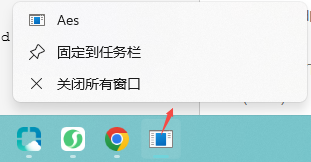C#实现窗口禁止固定到任务栏的完整指南
转载好友:https://www.cnblogs.com/wuty/p/19027532
在Windows应用程序开发中,有时我们需要控制窗口的某些系统级行为,比如禁止用户将应用程序窗口固定到任务栏。本文将详细介绍如何使用C#和Windows API实现这一功能,并深入解析相关技术原理
默认状态

通过 SHGetPropertyStoreForWindow 设置 System.AppUserModel.PreventPinning 属性 (System.AppUserModel.PreventPinning - Win32 apps | Microsoft Learn),达到如下效果

public class NativeWin32
{
[DllImport("shell32.dll")]
public static extern int SHGetPropertyStoreForWindow(IntPtr hwnd, ref Guid riid, out IPropertyStore propertyStore);
[DllImport("ole32.dll")]
public static extern int PropVariantClear(ref PROPVARIANT pvar);
// Define IPropertyStore interface
[ComImport]
[InterfaceType(ComInterfaceType.InterfaceIsIUnknown)]
[Guid("886D8EEB-8CF2-4446-8D02-CDBA1DBDCF99")]
public interface IPropertyStore
{
void GetCount(out uint cProps);
void GetAt(uint iProp, out PROPERTYKEY pkey);
void GetValue(ref PROPERTYKEY key, out PROPVARIANT pv);
void SetValue(ref PROPERTYKEY key, ref PROPVARIANT pv);
void Commit();
}
// Define IID for IPropertyStore
public static Guid IID_IPropertyStore = new Guid("886D8EEB-8CF2-4446-8D02-CDBA1DBDCF99");
// Define PROPERTYKEY struct
[StructLayout(LayoutKind.Sequential, Pack = 4)]
public struct PROPERTYKEY
{
public Guid fmtid;
public uint pid;
public PROPERTYKEY(Guid fmtid, uint pid)
{
this.fmtid = fmtid;
this.pid = pid;
}
}
// Define PROPVARIANT structure (simplified, we'll use a simple one for bool)
[StructLayout(LayoutKind.Explicit)]
public struct PROPVARIANT
{
// We'll only implement the necessary part for boolean
[FieldOffset(0)] public ushort vt;
[FieldOffset(8)] public byte boolVal;
public void SetValue(bool value)
{
// VT_BOOL
vt = 11;
boolVal = value ? (byte)1 : (byte)0;
}
}
}
应用使用:
/// <summary> /// MainWindow.xaml 的交互逻辑 /// </summary> public partial class MainWindow : Window { public MainWindow() { InitializeComponent(); SourceInitialized += MainWindow_SourceInitialized; } private void MainWindow_SourceInitialized(object sender, EventArgs e) { SetPinning(); } private void SetPinning() { IntPtr hwnd = new WindowInteropHelper(this).Handle; // Define the property key for System.AppUserModel.PreventPinning NativeWin32.PROPERTYKEY propKey = new NativeWin32.PROPERTYKEY(new Guid("{9F4C2855-9F79-4B39-A8D0-E1D42DE1D5F3}"), 9); // Get the IPropertyStore for the window NativeWin32.IPropertyStore propStore; int hr = NativeWin32.SHGetPropertyStoreForWindow(hwnd, ref NativeWin32.IID_IPropertyStore, out propStore); if (hr != 0) // if failed { Marshal.ThrowExceptionForHR(hr); } try { // Create a PROPVARIANT with bool value: true NativeWin32.PROPVARIANT pv = new NativeWin32.PROPVARIANT(); pv.SetValue(true); // Set the property propStore.SetValue(ref propKey, ref pv); // We must free the PROPVARIANT NativeWin32.PropVariantClear(ref pv); } finally { // Release the IPropertyStore Marshal.ReleaseComObject(propStore); } } }
参考资料:System.AppUserModel.PreventPinning - Win32 apps | Microsoft Learn

 浙公网安备 33010602011771号
浙公网安备 33010602011771号